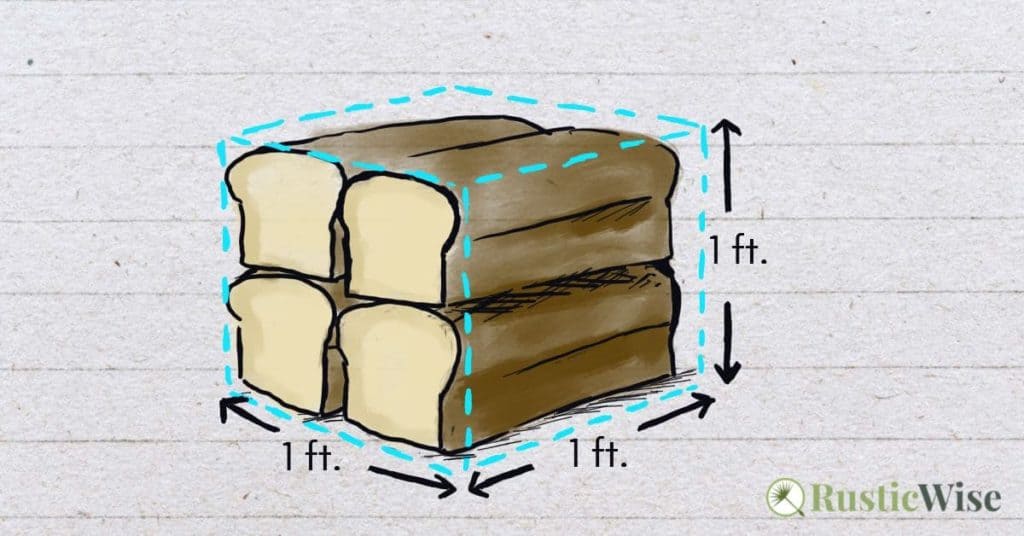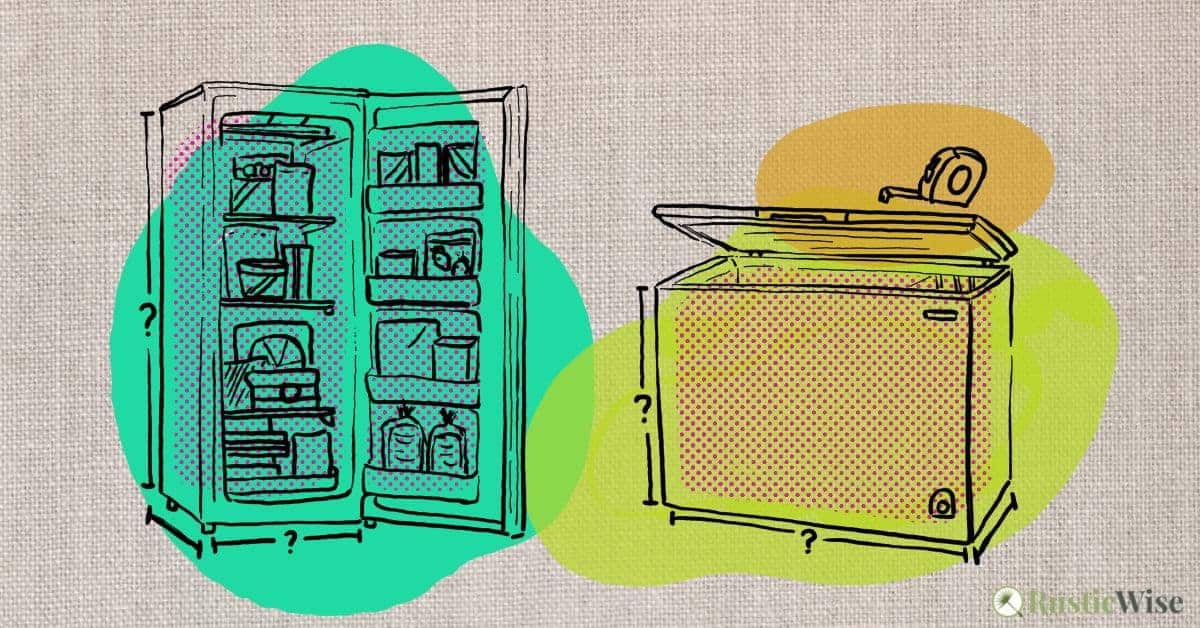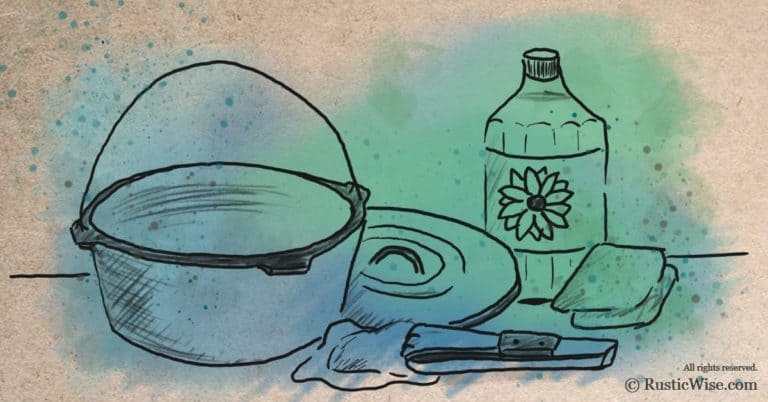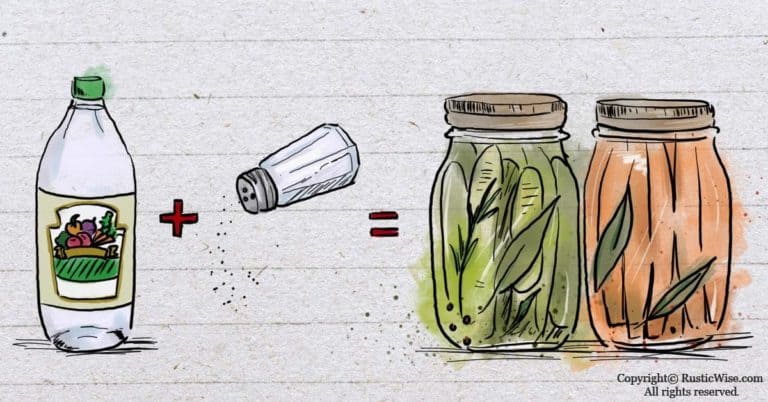How Much Will a Medium Freezer Hold (10 to 16 Cubic Feet)?
RusticWise is supported by its readers. When you purchase through links on our site, we may earn an affiliate commission. As an Amazon Associate, we earn from qualifying purchases. Thank You!
Are you looking to add extra frozen food storage to your home? If you’re wondering how much a medium freezer will hold, the answer is about 420–560 pounds (191–254 kilograms) of food. This would accommodate six to 10 people (based on the assumption that each person requires 1.5 cubic feet of food storage).
A freezer is such a useful home appliance. Stock up on frozen fruits and vegetables. Freeze that leftover turkey. Stash an assortment of your favorite ice cream flavors. If you’re looking to add a significant amount of extra food storage, a medium freezer (between 10 to 16 cubic feet) may just be what you’re looking for.
Let’s look at whether medium freezer would be right for you.
Standard freezer sizes
Standalone deep freezers come in four basic sizes¹. Choosing a medium freezer may be the perfect size for you—not too big, and not too small.
| Type | Freezer Capacity (cubic feet) |
|---|---|
| Compact | 3 to 5 cu. ft. |
| Small | 6 to 9 cu. ft. |
| Medium | 10 to 16 cu. ft. |
| Large | 17+ cu. ft. |
10 vs. 12 cubic feet freezer
Are you trying to decide between buying a 10 vs. 12 cubic feet freezer? Here are some storage differences. A 10 cubic feet freezer has a capacity of 350 pounds (159 kilograms), while a 12 cubic feet freezer can hold 420 pounds (191 kilograms) of food.
A 12 cubic foot freezer can hold 70 pounds (32 kilograms) more food.
You might like
Commercial Chest Freezer – Kitma 9.6 cu. ft.
- Dimensions: 40.5 X 26.5 X 32.5 inches
- Two removable interior baskets
- Adjustable temperature control
Found on Amazon
Check Current Price
Those in Canada and the UK should be taken to the product listing in your region.
A closer look at 13, 14, and 15 cubic feet freezers
In the medium-sized freezer category, 13, 14, and 15 cubic feet freezers are popular choices. Let’s look at the holding capacity of each.
| Freezer Size (cubic feet) | Food Storage (pounds/kilograms) |
|---|---|
| 13 cu. ft. | 455 lbs. / 206 kg |
| 14 cu. ft. | 490 lbs. / 222 kg |
| 15 cu. ft. | 525 lbs./238 kg |
How to calculate amount of freezer storage space required
The average person requires between 1.5–2.5 cubic feet of freezer storage space.
To calculate how much freezer space you’ll need, multiply the number of people in your household by 1.5–2.5 cubic feet.
Use this range of 1.5 to 2.5 as a guideline and adjust it according to your lifestyle and needs. For example, if you have more modest freezer needs, use 1.5 as a baseline. If you have small children, using 1.5 cubic feet of storage would make sense. If you like to stock up on freezer food, then you’ll probably want to multiply by 2.5 cubic feet.
How much will a medium freezer hold: different scenarios
We mentioned above that a general guideline is to multiply the number of people in your household by 1.5–2.5 cubic feet to determine how many cubic feet of freezer space you’ll need.
Here’s a chart outlining a rough guideline of freezer storage needs based on household composition. We’ve multiplied adults by 2.5, and children by 1.5.
Generally, a medium (10 to 16 cubic feet) freezer is sufficient for a household with six to 10 people, depending on individual needs.
| Household | Freezer Storage Needs (cubic feet) |
|---|---|
| Two adults | 5 cu. ft. |
| Two adults, two young children | 8 cu. ft. |
| Two adults, three young children | 9.5 cu. ft. |
| Four adults | 10 cu. ft. |
How many pounds of food can 1 cubic foot hold?
A general guideline is that 1 cubic foot holds approximately 35 pounds (16 kilograms) of food².
Keep in mind that packaging and overall size play a large role in how much you can cram into 1 cubic foot. For example, 10 pounds of roast beef will be more compact than 10 pounds of baked goods.
How much food fits in 1 cubic foot?
If all these numbers are confusing, let’s look at what you can comfortably fit into: 1 cubic foot (1 foot X 1 foot X 1 foot).
Based on my own calculations, you can fit about four standard loaves of bread in 1 cubic foot (the loaves fit 2 X 2).

Choose a freezer that fits your household needs
There are many factors to consider when deciding on the proper freezer size. While budget and freezer features are important to consider, let’s not forget about your basic household needs and preferences.
Household needs and lifestyle
Do you like to have freezer meals to make meal prep easier?
Chances are, if you’re looking to buy a medium-size freezer, you’re probably planning to use it for several reasons:
- Freeze fresh fruits and vegetables from the garden
- Buy meat in bulk to stock up
- Stock up on bulk food items at the grocery store (hello frozen pizzas!)
- Cook large batches of food and sauces for to freeze for later
- Freeze leftovers to avoid food waste
Taking a realistic look at your household needs is one of the most important considerations when determining the freezer size.
If you’re only looking to store a bucket of ice cream, a loaf of bread and not much else, you might consider getting a small or compact freezer.
You might like
Deep Freezer Baskets with Handles, Pearl White, Set of 3
- Dimensions: 11.8″ (L) x 11.8″ (W) x 7″ (H)
- Specifically designed for freezer use, but also great for the fridge.
- Wire grid made of sturdy PE coated steel.
Found on Amazon
Check Current Price
Those in Canada and the UK should be taken to the product listing in your region.
Freezer style
There are two main types of standalone freezers: upright freezer or chest freezer (aka box freezer).
An upright model looks similar to a standard refrigerator with a door that swings open from side-to-side. They have adjustable shelves. If you like to keep your food organized and have different freezer sections, an upright freezer may be what you’re looking for. The benefit to upright freezers is they take up less floor space and provide easy-access to food.
The downside to upright freezers is they hold less than chest freezers. According to Consumer Reports3, the shelves and bins of upright freezers take up about 20 percent more space than those in chest freezers, leaving you with less available cubic footage.
Chest freezers have doors that open horizontally. They have a greater storage capacity than upright models and hold more food per cubic foot. Food stays cooler in a chest freezer. In case of a power outage, food stored in a chest freezer can often stay cool for a longer time than an upright freezer. New or used chest freezers generally cost less than upright freezers.
The downside to chest freezers is they take up more floor space. It’s also more difficult to reach foods on the bottom. To prevent the foods at the bottom from turning into a freezer burn wasteland, try to use foods in a timely manner. Consider buying freezer bins or wire baskets to keep frozen foods organized so you can use the oldest foods first.
Available space
How much extra space you have at home largely determines the size and type of freezer you buy: upright vs. chest freezer. (If you’re short on space inside your home, one potential option is to keep your freezer in the garage)
Remember to allow for at least 1 inch of space (preferably more) between the back of the freezer and the nearest wall, plus several inches of clearance all around. This provides sufficient airflow around the appliance, which keeps it running in optimal condition.
The best place to put a deep freezer is in a cool, dry room away from windows and sunlight, and other heat sources.
Why getting the right freezer size matters
When choosing the right freezer size, you want to get one that’s not too big or too small, but just right.
When you buy a freezer that’s the proper size for your household needs, this helps to optimize freezer efficiency and ensure food safety.
Freezers that are jam-packed have poor air circulation. When air isn’t able to move around freely, some foods stay cold, while others get too warm; this leads to potential food safety and temperature control issues. When your freezer is too full, the freezer compressor works in overdrive. It’s important to leave room at the top and along the sides of the freezer compartment for adequate airflow.
On the other hand, freezers that sit mostly empty are inefficient. While it’s fine to leave some empty freezer space, too much empty space requires a lot of energy to keep cool.
If you want to fill up an empty freezer, use this trick.
Fill clean milk jugs or other juice containers with water (remember to leave space at the top for expansion). Ziploc bags filled with water or ice cubes will also work. When your freezer is sufficiently full, it prevents temperature fluctuations from occurring every time you open the door.
Tip: The sweet spot is to aim for a freezer that’s around 70-85 percent full4. This allows proper air circulation while also optimizing energy efficiency.
How many pounds of frozen meat will a 10 cubic foot chest freezer hold?
Stocking up on meat is one of the more common reasons people are looking to buy a medium-sized freezer. With such a short shelf life, it makes sense if you want to buy meat in bulk and stock up.
If you’re wondering how much frozen meat fits in a 10 cubic feet freezer, it’s approximately 35–40 pounds of meat per each cubic foot⁵. This means you could fit about 350–400 pounds (159–181 kilograms) of meat, or roughly half a beef.
The takeaway: how much will a medium freezer hold?
A medium freezer between 10 and 16 cubic feet will hold approximately 420–560 pounds (191–254 kilograms) of food and may be enough for six to 10 people. In terms of meat storage, a medium freezer holds a half a beef. When deciding on a freezer, remember to consider your lifestyle needs and whether an upright model vs. chest freezer is right for you.
If you have room for a medium-sized freezer, it provides peace of mind knowing that you have extra frozen food at home.
Related questions
What’s the ideal temperature for a deep freezer?
The U.S. Food & Drug Administration (FDA)⁶ recommends keeping your freezer temperature at 0 degrees Fahrenheit (-18 degrees Celsius) or lower. Foods properly packaged and stored at this temperature can in theory, last indefinitely. However, most frozen foods may deteriorate in quality and taste (and likely develop freezer burn over time). So enjoy your frozen foods sooner rather than later!
How long can meat be frozen and still maintain its quality?
The U.S. Department of Health & Human Services⁷ has a few guidelines for recommended food storage in the freezer for optimal quality.
Table: Frozen Meat Storage Guidelines
| Food | Freezer (0 °F or below) |
|---|---|
| Bacon | 1 month |
| Hot dogs | 1 to 2 months |
| Luncheon meat | 1 to 2 months |
| Sausage (either raw or fully cooked), from chicken, turkey, pork, or beef | 1 to 2 months |
| Sausage, purchased frozen | 1-2 months from date of purchase |
| Hamburger, ground beef, turkey, chicken, other poultry, veal, pork, lamb, and mixtures of them | 3 to 4 months |
| Steaks | 4 to 12 months |
| Chops | 4 to 12 months |
| Roasts | 4 to 12 months |
| Ham (fresh, uncured, uncooked) | 6 months |
| Ham (cooked, store-wrapped, whole) | 1 to 2 months |
| Country ham, cooked | 1 month |
| Chicken or turkey, whole | 1 year |
| Leftover cooked meat or poultry | 2 to 6 months |
| Lean fish (cod, flounder, haddock, halibut, sole, etc.) | 6 – 8 Months |
| Shrimp, Squid, Crayfish | 6 – 18 Months |
How big is a standard freezer?
There’s not really a definitive “standard” size of freezer. But just to give you a rough idea, a standard refrigerator freezer (with a top-freezer) has a storage capacity of around 4–5 cubic feet.
The most popular standalone freezer sizes are: 3.5, 5, 7, and 10 cubic feet.
Keep in mind that people who live on farms and rural areas have different needs than city dwellers. Space constraints are the biggest issue for many people in the city, which is why compact or small freezers are more common in urban areas. My husband grew up on a farm where they had two large freezer chests (18+ cubic feet), side-by-side.
How to measure and calculate freezer capacity
We measure freezers in cubic feet, which measures volume. (Imagine a cube with sides that measure 1 foot each.)
To calculate freezer capacity, measure the interior of your freezer’s length, width and height. (Convert your measurement to feet if you measured in inches or centimeters.)
Finally, multiply the three numbers together (in feet): Length X Width X Height
The answer gives you a rough idea of your freezer’s capacity.
Check out related posts:
👉 How Much Will a 1-5 Cubic Foot (Compact) Freezer Hold?
👉 How Much Will a Small Freezer Hold (6 to 9 Cubic Feet)?
👉 How Much Will a Large Freezer Hold (17+ Cubic Feet)?

References
- Maytag, Guide to Freezer Sizes and Dimensions, https://www.maytag.com/blog/kitchen/freezer-sizes-and-dimensions-guide.html. Accessed October 2021.
- Lowe’s, Freezer Buying Guide, https://www.lowes.com/n/buying-guide/freezer-buying-guide . Accessed October 2021.
- Consumer Reports, Freezer Buying Guide, https://www.consumerreports.org/cro/freezers/buying-guide/index.htm . Accessed October 2021.
- Sears Home Services, 5 Most Common Freezer Problems and Solutions, https://www.searshomeservices.com/blog/5-most-common-freezer-problems-and-solutions. Accessed October 2021.
- Sparacio, Micah (23 March 2020). “ How Much Beef Can I Fit in a Freezer? “, Cove Creek Farm. Accessed October 2021.
- U.S. Food & Drug Administration (FDA), Are You Storing Food Safely?, https://www.fda.gov/consumers/consumer-updates/are-you-storing-food-safely. Accessed October 2021.
- FoodSafety.gov website (U.S. Department of Health & Human Services), Cold Food Storage Chart, https://www.foodsafety.gov/food-safety-charts/cold-food-storage-charts. Accessed October 2021.

Author: Theresa Tesolin
Theresa is co-founder of RusticWise. She helps people unleash their inner DIY spirit by encouraging them to get dirty and make or grow something from scratch.












